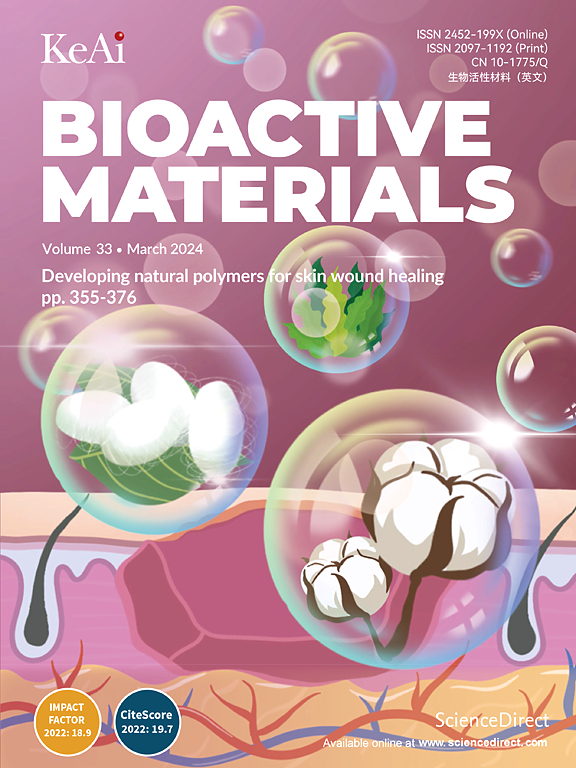铜-木犀草素纳米复合物在炎症性肠病中介导氧化应激、肠屏障和肠道微生物群的多方面调节。
IF 18
1区 医学
Q1 ENGINEERING, BIOMEDICAL
引用次数: 0
摘要
氧化应激、菌群失调和免疫失调已被证实在炎症性肠病(IBD)复杂的发病机制中发挥着关键作用。在此,我们通过金属-多酚配位策略设计了铜离子-木犀草素纳米络合物(CuL NCs),它在改善 IBD 方面发挥着多方面的作用。所制备的 CuL NCs 具有极高的稳定性和清除活性氧(ROS)的能力,因此可作为具有卓越抗氧化和抗炎能力的治疗药物。它能有效调节炎症微环境,包括促进有效降低促炎细胞因子水平、保护肠上皮细胞、促进粘膜屏障修复和调节肠道微生物群。此外,研究还发现 CuL NCs 可分别通过调节核因子红细胞 2 相关因子 2/血红素氧合酶 1(Nrf2/HO-1)氧化应激途径和核因子卡巴 B(NF-κB)信号途径,增强细胞的抗氧化和抗炎能力。值得注意的是,CuL NCs 在溃疡性结肠炎(UC)和克罗恩病(CD)等典型 IBD 小鼠模型中显示出显著的预防和治疗效果。这项研究为建立天然产品治疗 IBD 的多元治疗平台提供了一种新方法。本文章由计算机程序翻译,如有差异,请以英文原文为准。

Copper–luteolin nanocomplexes for Mediating multifaceted regulation of oxidative stress, intestinal barrier, and gut microbiota in inflammatory bowel disease
Oxidative stress, dysbiosis, and immune dysregulation have been confirmed to play pivotal roles in the complex pathogenesis of inflammatory bowel disease (IBD). Herein, we design copper ion–luteolin nanocomplexes (CuL NCs) through a metal–polyphenol coordination strategy, which plays a multifaceted role in the amelioration of IBD. The fabricated CuL NCs function as therapeutic agents with exceptional antioxidant and anti-inflammatory capabilities because of their great stability and capacity to scavenge reactive oxygen species (ROS). It can effectively modulate the inflammatory microenvironment including facilitating the efficient reduction of pro-inflammatory cytokine levels, protecting intestinal epithelial cells, promoting mucosal barrier repair and regulating intestinal microbiota. In addition, CuL NCs have been found to enhance cellular antioxidant and anti-inflammatory capacities by regulating the nuclear factor erythroid 2–related factor 2/heme oxygenase-1 (Nrf2/HO-1) oxidative stress pathway and nuclear factor kappa B (NF-κB) signaling pathway, respectively. Notably, CuL NCs demonstrate significant prophylactic and therapeutic efficacy in mouse models with typical IBD, including ulcerative colitis (UC) and Crohn's disease (CD). This study provides a new approach for building multifaceted therapeutic platforms for natural products to treat IBD.
求助全文
通过发布文献求助,成功后即可免费获取论文全文。
去求助
来源期刊

Bioactive Materials
Biochemistry, Genetics and Molecular Biology-Biotechnology
CiteScore
28.00
自引率
6.30%
发文量
436
审稿时长
20 days
期刊介绍:
Bioactive Materials is a peer-reviewed research publication that focuses on advancements in bioactive materials. The journal accepts research papers, reviews, and rapid communications in the field of next-generation biomaterials that interact with cells, tissues, and organs in various living organisms.
The primary goal of Bioactive Materials is to promote the science and engineering of biomaterials that exhibit adaptiveness to the biological environment. These materials are specifically designed to stimulate or direct appropriate cell and tissue responses or regulate interactions with microorganisms.
The journal covers a wide range of bioactive materials, including those that are engineered or designed in terms of their physical form (e.g. particulate, fiber), topology (e.g. porosity, surface roughness), or dimensions (ranging from macro to nano-scales). Contributions are sought from the following categories of bioactive materials:
Bioactive metals and alloys
Bioactive inorganics: ceramics, glasses, and carbon-based materials
Bioactive polymers and gels
Bioactive materials derived from natural sources
Bioactive composites
These materials find applications in human and veterinary medicine, such as implants, tissue engineering scaffolds, cell/drug/gene carriers, as well as imaging and sensing devices.
 求助内容:
求助内容: 应助结果提醒方式:
应助结果提醒方式:


